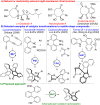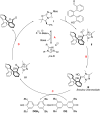Enantioselective lactonization catalyzed by chiral N-heterocyclic carbenes enables access to inherently chiral eight-membered lactones
- PMID: 40901621
- PMCID: PMC12400956
- DOI: 10.1039/d5sc05037e
Enantioselective lactonization catalyzed by chiral N-heterocyclic carbenes enables access to inherently chiral eight-membered lactones
Abstract
Chiral saddle-shaped molecules are an emerging class of compounds with significant potential in both materials science and medicinal chemistry. However, their broader application has been hindered by limited synthetic accessibility. Herein, we report a metal-free, organocatalytic protocol for the oxidative lactonization of readily available aldehydic derivatives, enabling the efficient synthesis of chiral saddle-shaped lactones. The method exhibits excellent enantiocontrol, high yields (nearly quantitative), and broad functional group tolerance, as demonstrated by the synthesis of a small library of structurally diverse products. The scalability of the reaction further underscores its practical utility. Moreover, computational studies provide mechanistic insight into the origin of enantioinduction in N-heterocyclic carbene-catalyzed lactonization.
This journal is © The Royal Society of Chemistry.
Conflict of interest statement
There are no conflicts to declare.
Figures




Similar articles
-
Carbene-Catalyzed Intramolecular Cyclization to Access Inherently Chiral Saddle-Shaped Lactones: Achiral Bases Alternate Product Chirality.J Am Chem Soc. 2025 Aug 27;147(34):30747-30756. doi: 10.1021/jacs.5c05380. Epub 2025 Jun 19. J Am Chem Soc. 2025. PMID: 40534275
-
The Role of Anions in Guanidinium-Catalyzed Chiral Cation Ion Pair Catalysis.Acc Chem Res. 2025 Jul 15;58(14):2269-2281. doi: 10.1021/acs.accounts.5c00283. Epub 2025 Jun 30. Acc Chem Res. 2025. PMID: 40587427
-
Carbene-Catalyzed Asymmetric Acetalization to Access Chiral 3-Aryloxyphthalides.Chem Asian J. 2025 Aug;20(16):e00076. doi: 10.1002/asia.202500076. Epub 2025 May 16. Chem Asian J. 2025. PMID: 40377127
-
Primary Amine-Based Photoclick Chemistry: From Concept to Diverse Applications in Chemical Biology and Medicinal Chemistry.Acc Chem Res. 2025 Jul 1;58(13):1963-1981. doi: 10.1021/acs.accounts.5c00158. Epub 2025 Jun 18. Acc Chem Res. 2025. PMID: 40532071 Review.
-
Updates on Intrinsic Medicinal Chemistry of 1,4-dihydropyridines, Perspectives on Synthesis and Pharmacokinetics of Novel 1,4-dihydropyrimidines as Calcium Channel Blockers: Clinical Pharmacology.Curr Top Med Chem. 2025;25(11):1351-1376. doi: 10.2174/0115680266323908241114064318. Curr Top Med Chem. 2025. PMID: 39754778 Review.
References
-
- Yao T. Li J. Jiang C. Zhao C. Chem Catal. 2022;2:2929.
-
- Otevrel J. Eugui M. Ričko S. Jørgensen K. A. Nat. Synth. 2023;2:1142.
- Kotwal N. Tamanna N. Chauhan P. Chem. Commun. 2022;58:11031. - PubMed
- Zhang X. Lin L. Li J. Duan S. Long Y. Li J. Chin. J. Org. Chem. 2021;41:1878.
- Clarke A. K. Unsworth W. P. Chem. Sci. 2020;11:2876. - PMC - PubMed
- Hussain A. Yousuf S. K. Mukherjee D. RSC Adv. 2014;4:43241.
-
- Tang M. Yang X. Eur. J. Org Chem. 2023;26:e202300738.
-
- Han J. W. Peng X. S. Wong H. N. C. Natl. Sci. Rev. 2017;4:892.
-
- Bachrach J. M. J. Org. Chem. 2009;74:3609. - PubMed
Associated data
LinkOut - more resources
Full Text Sources

